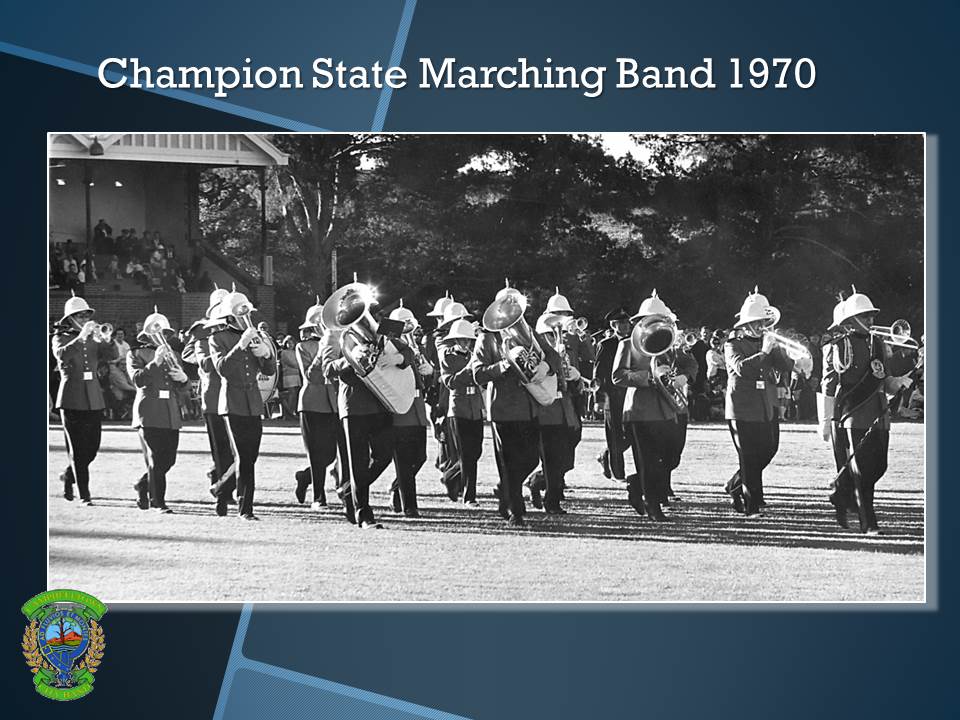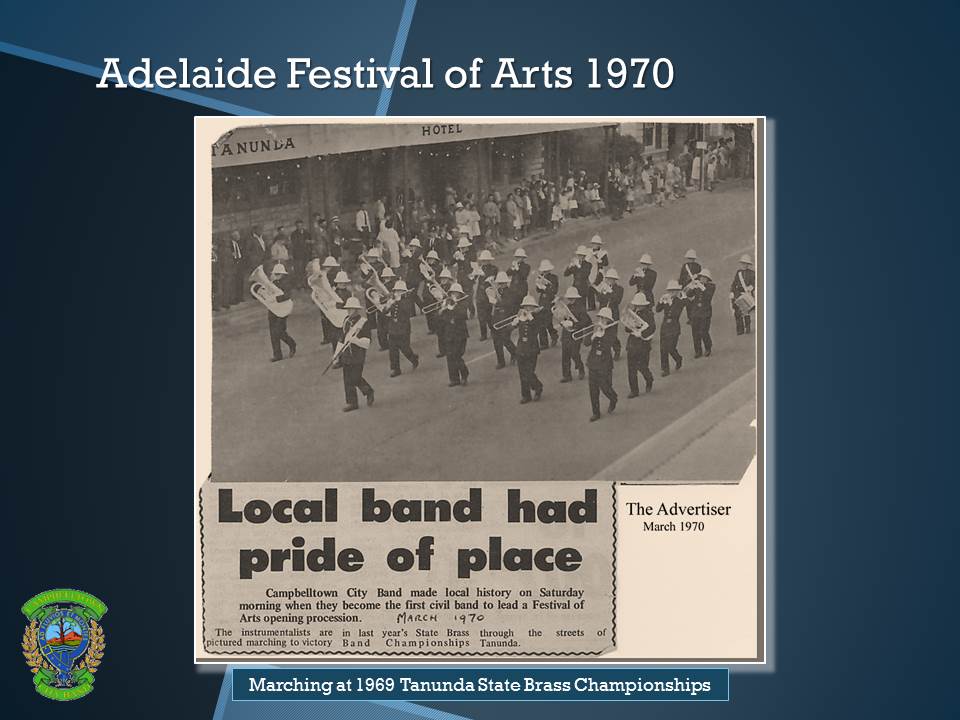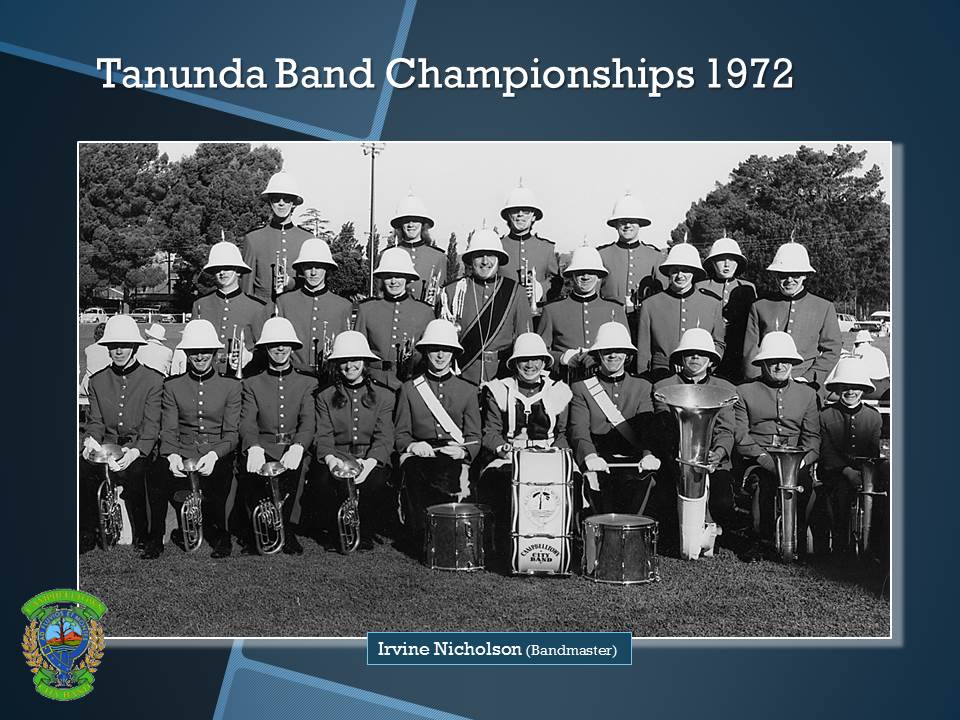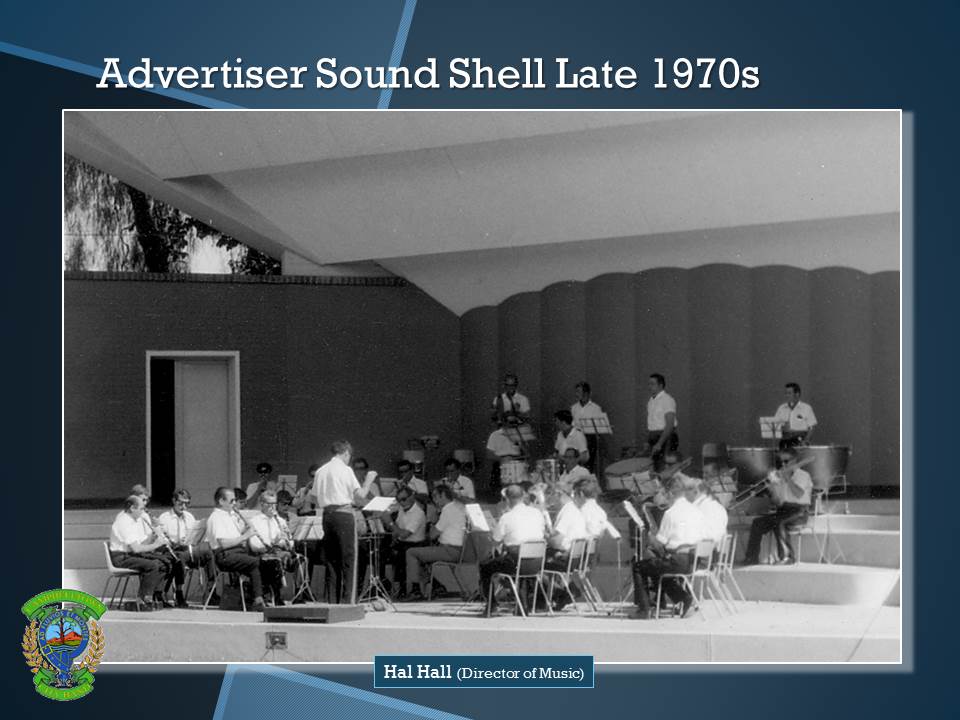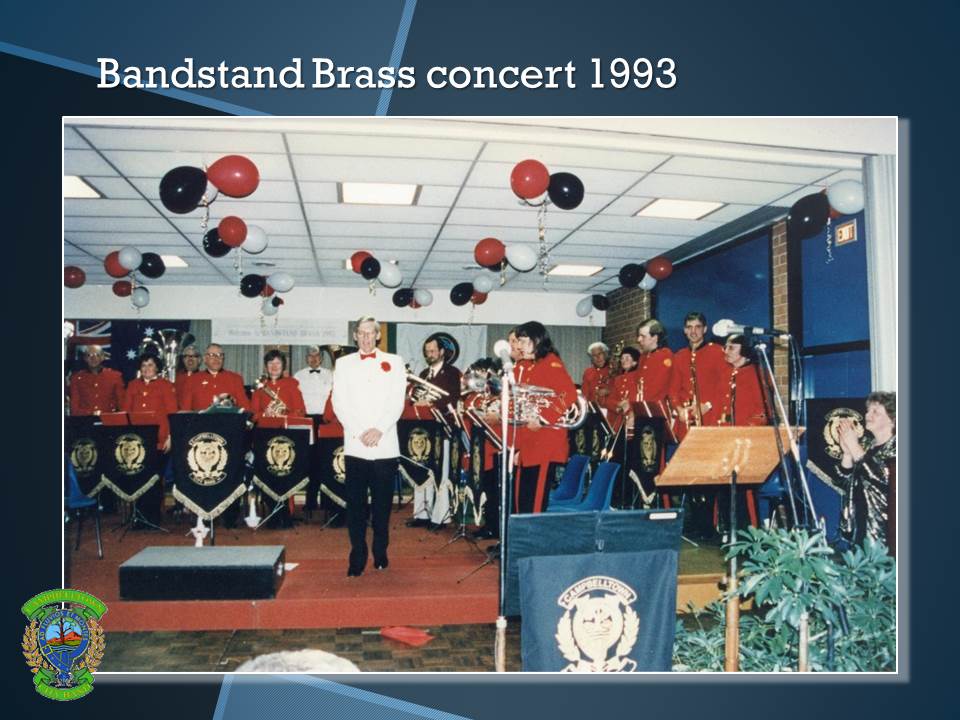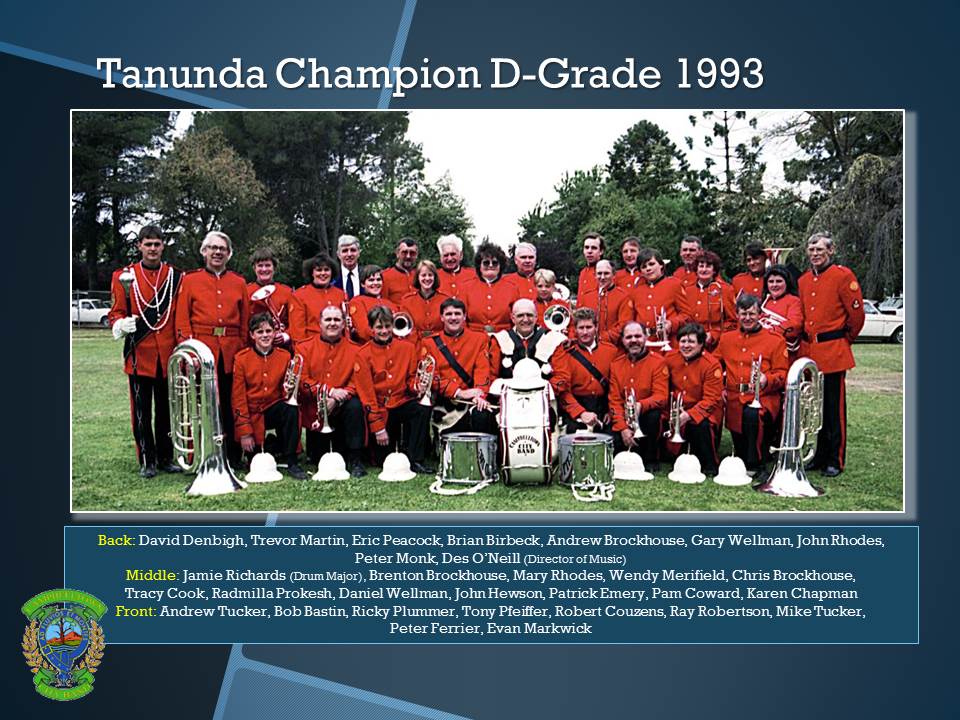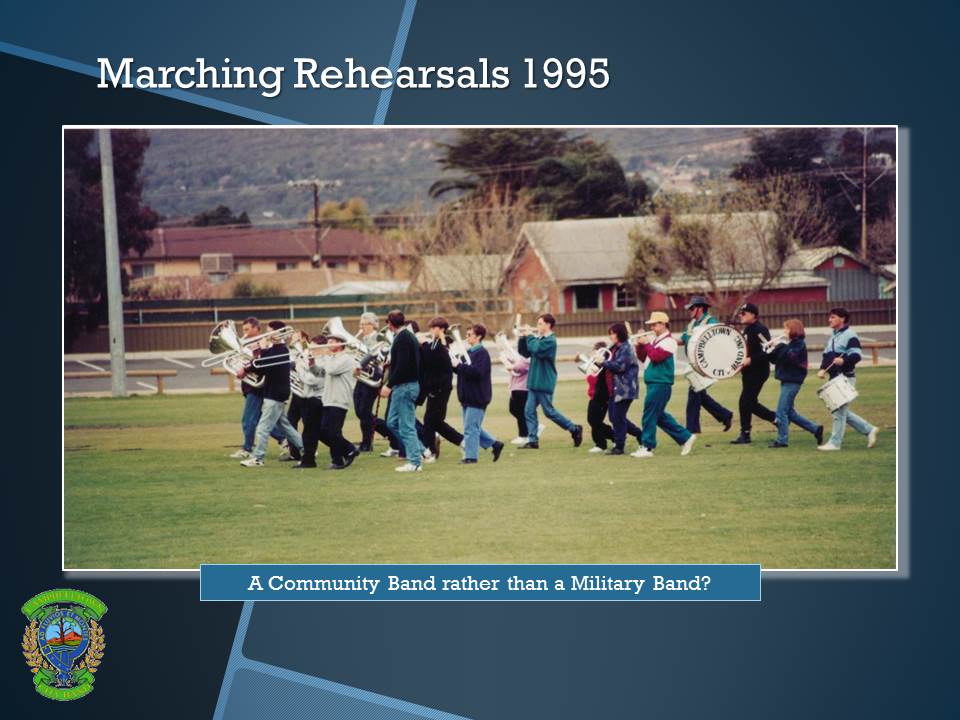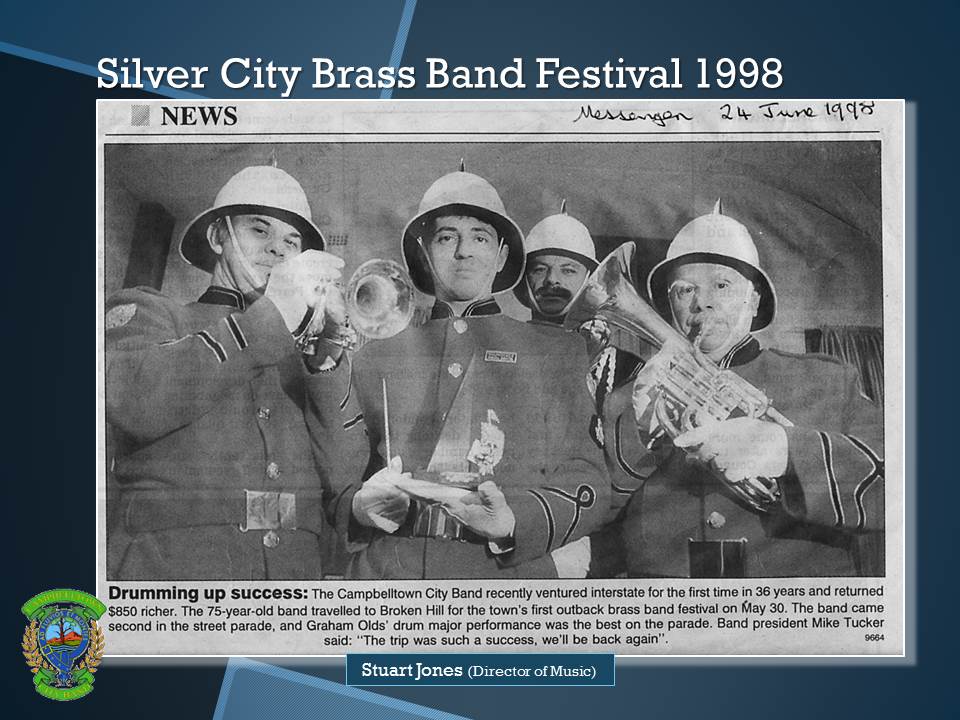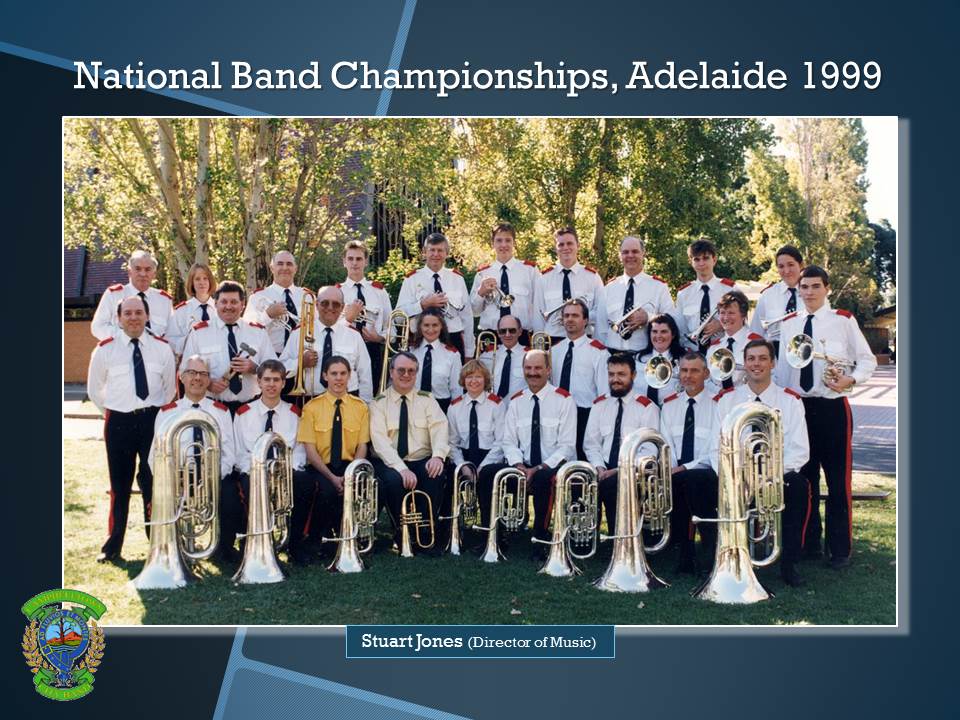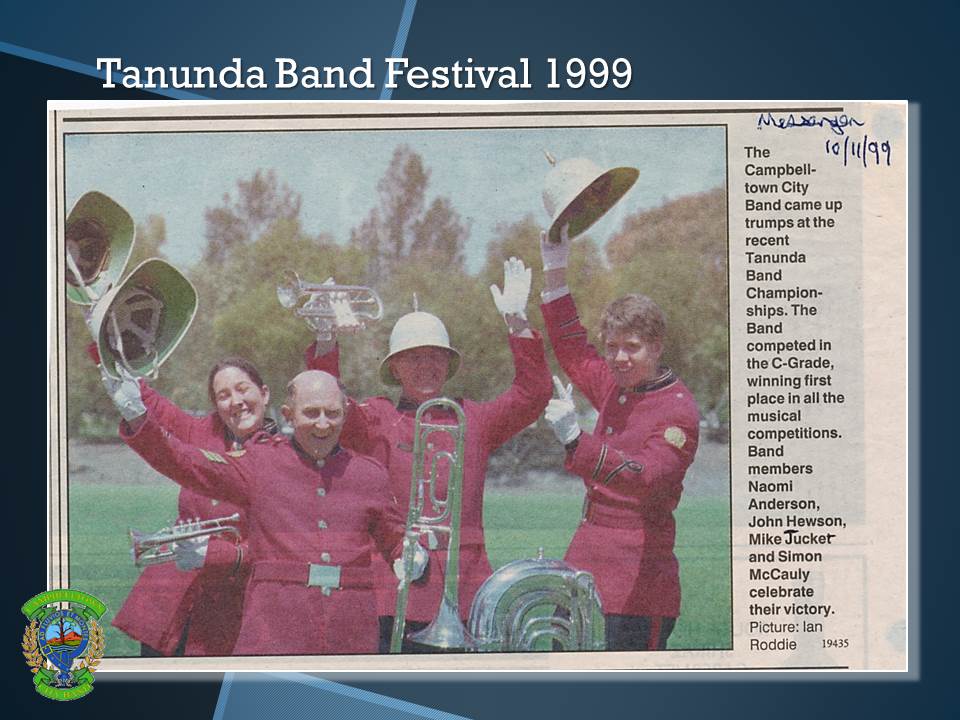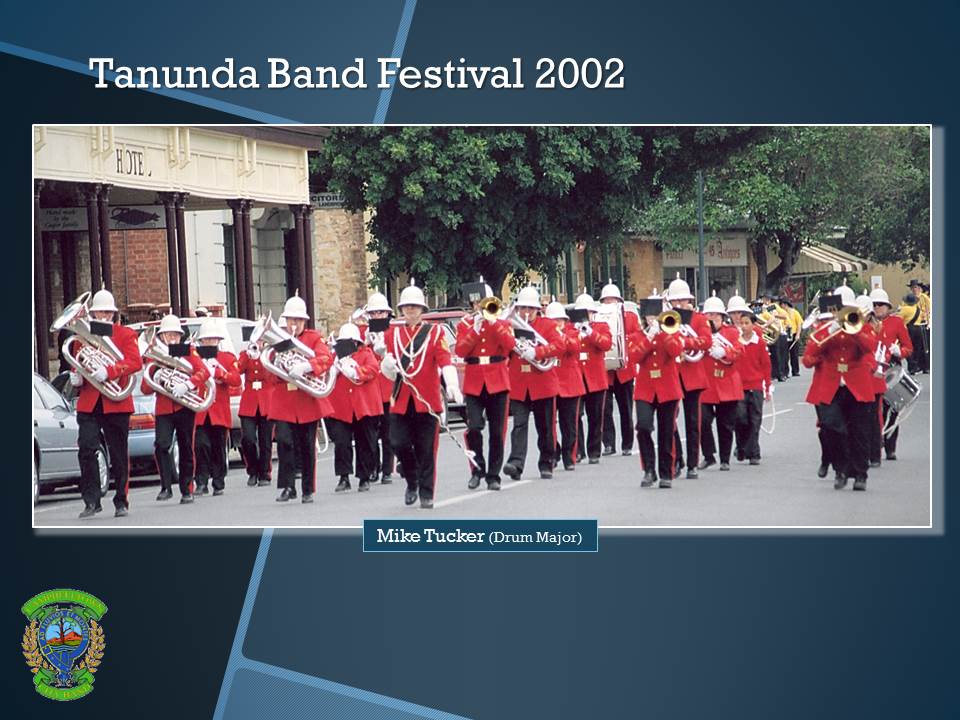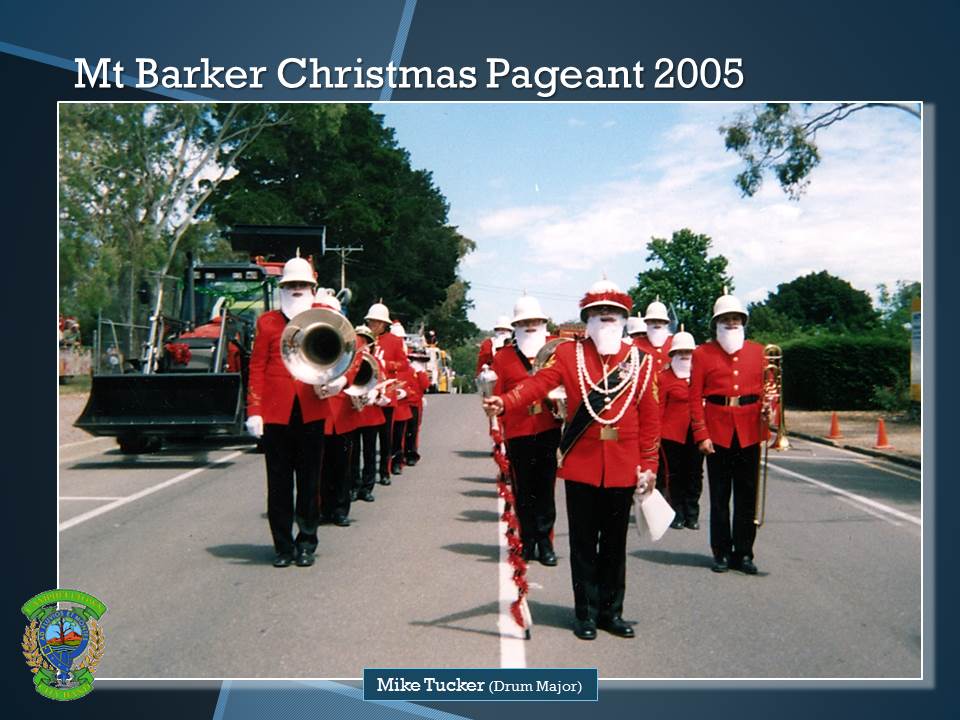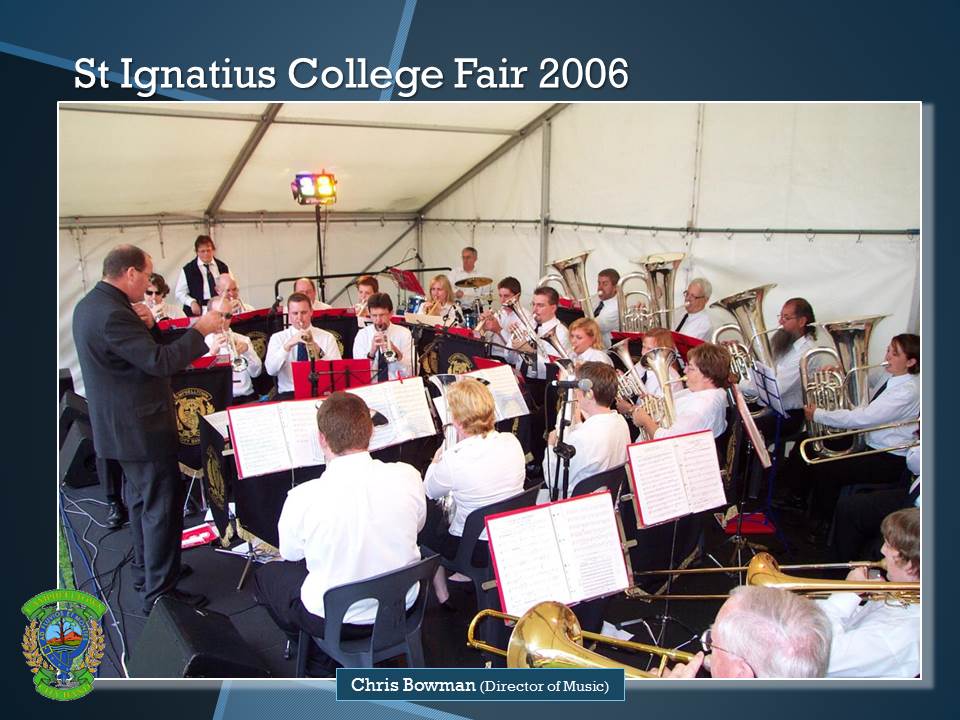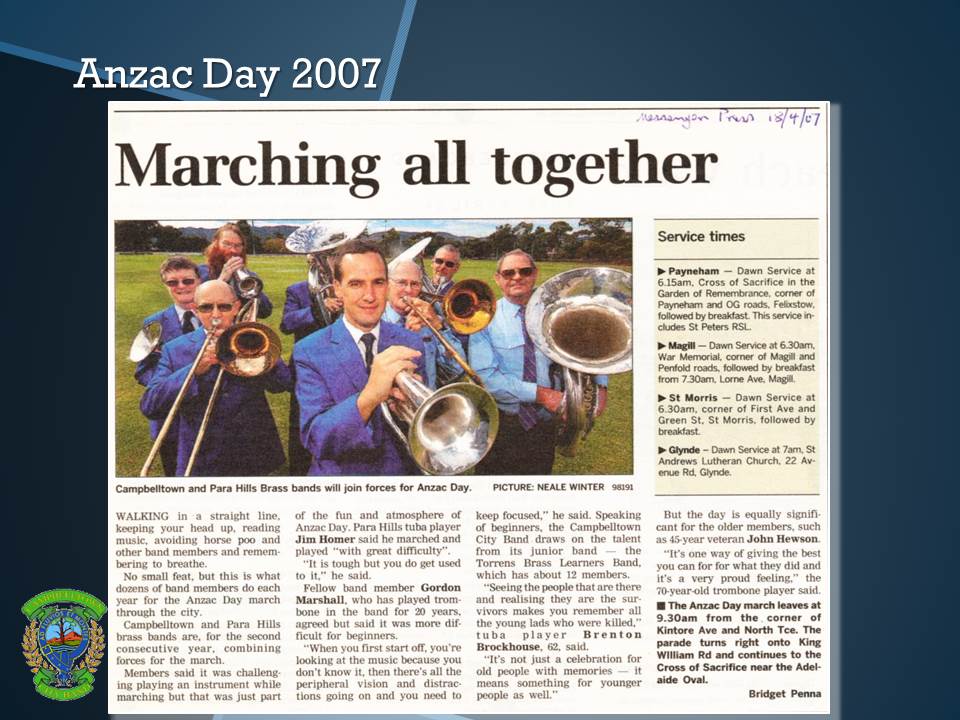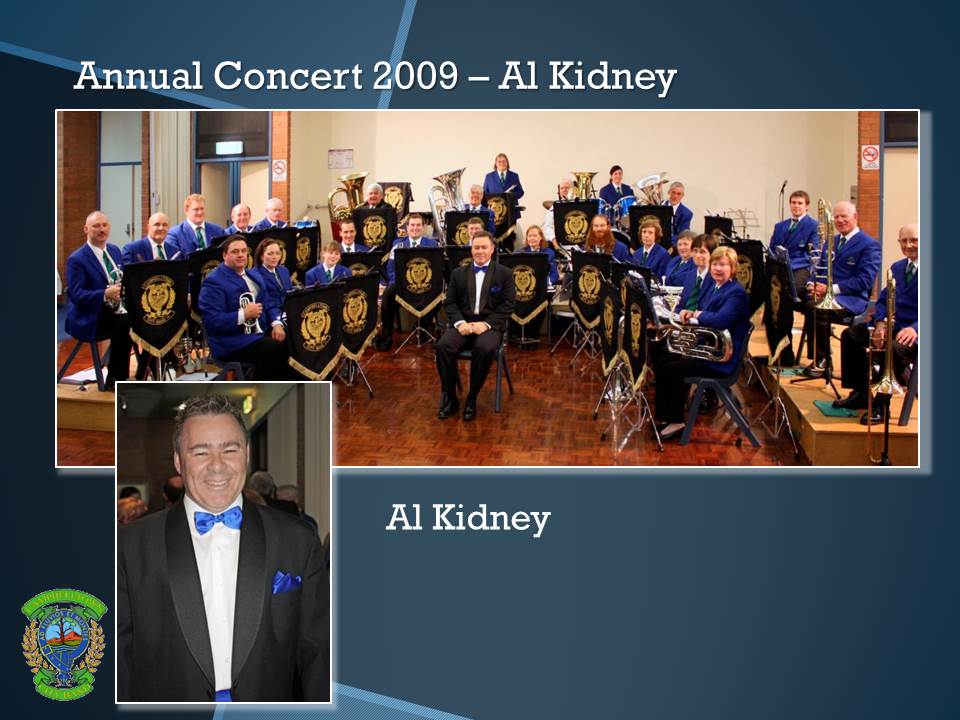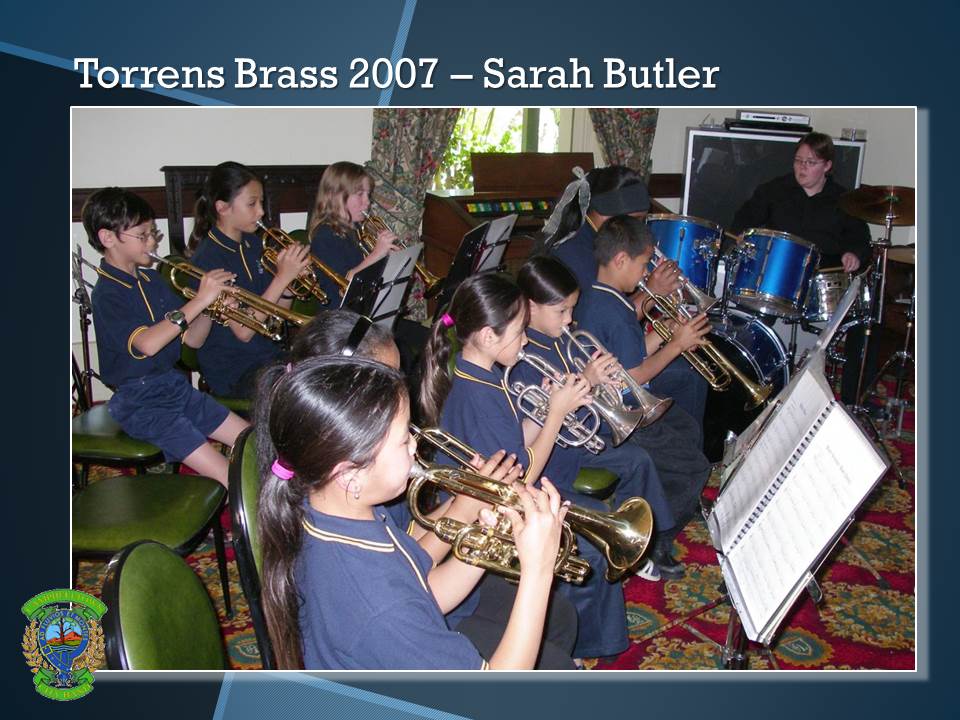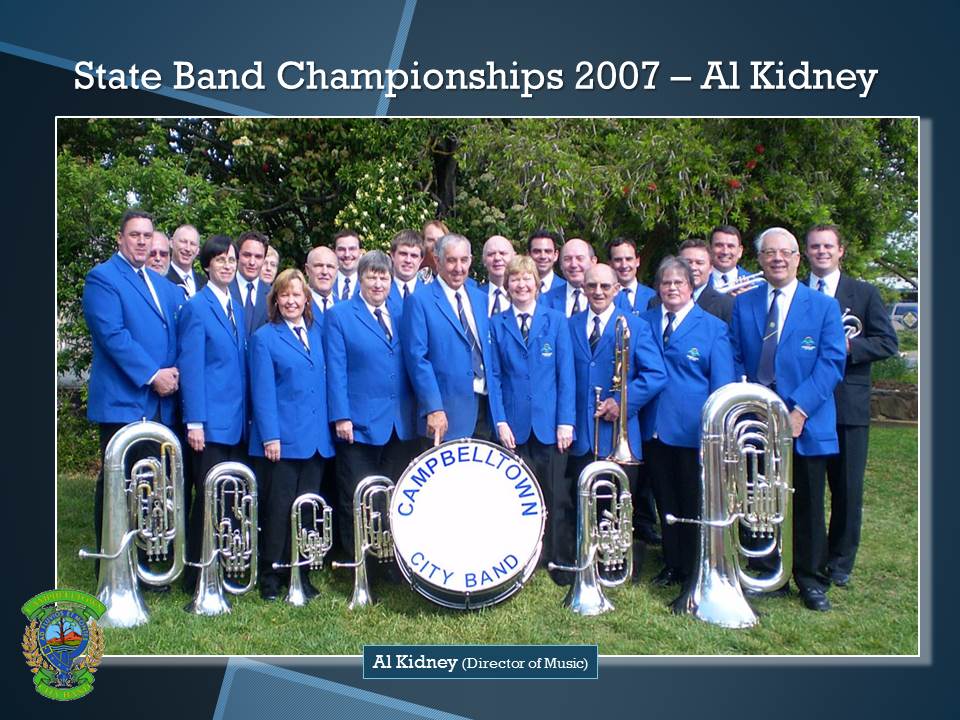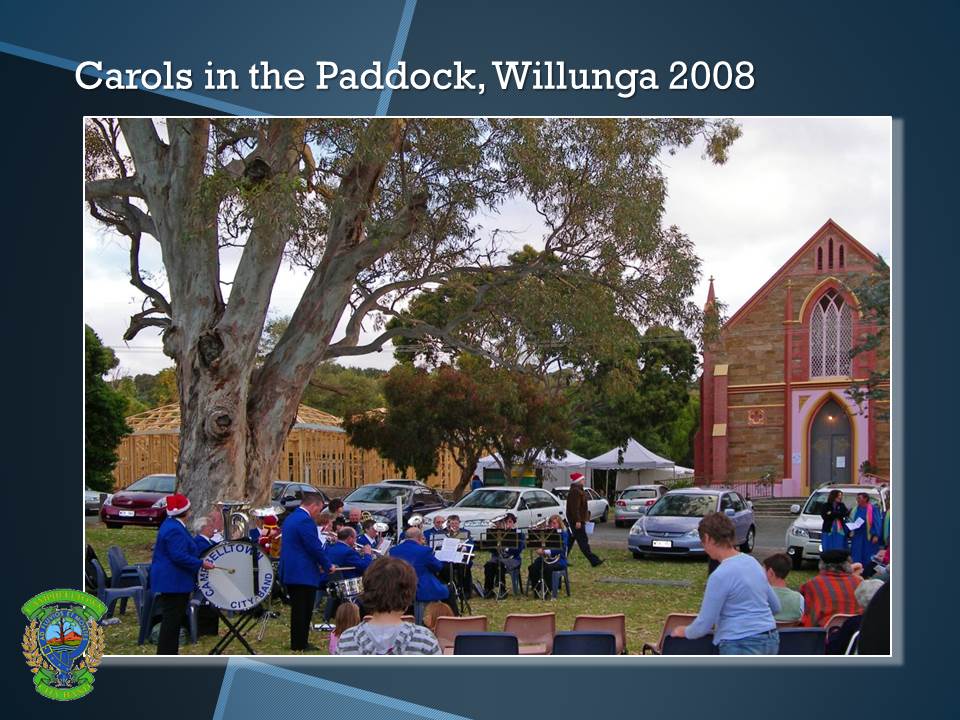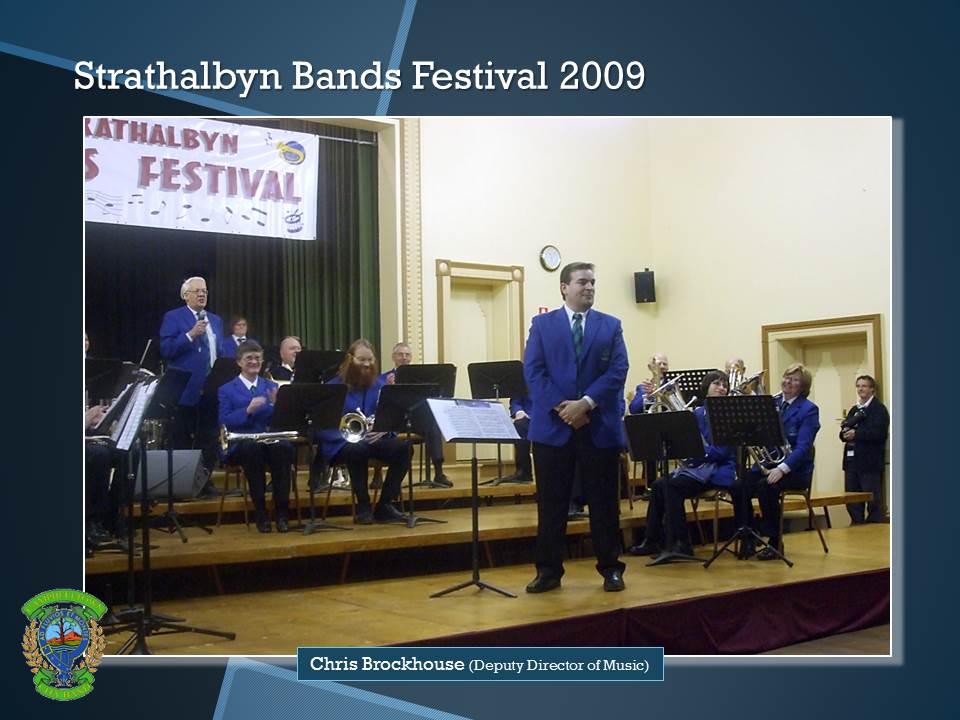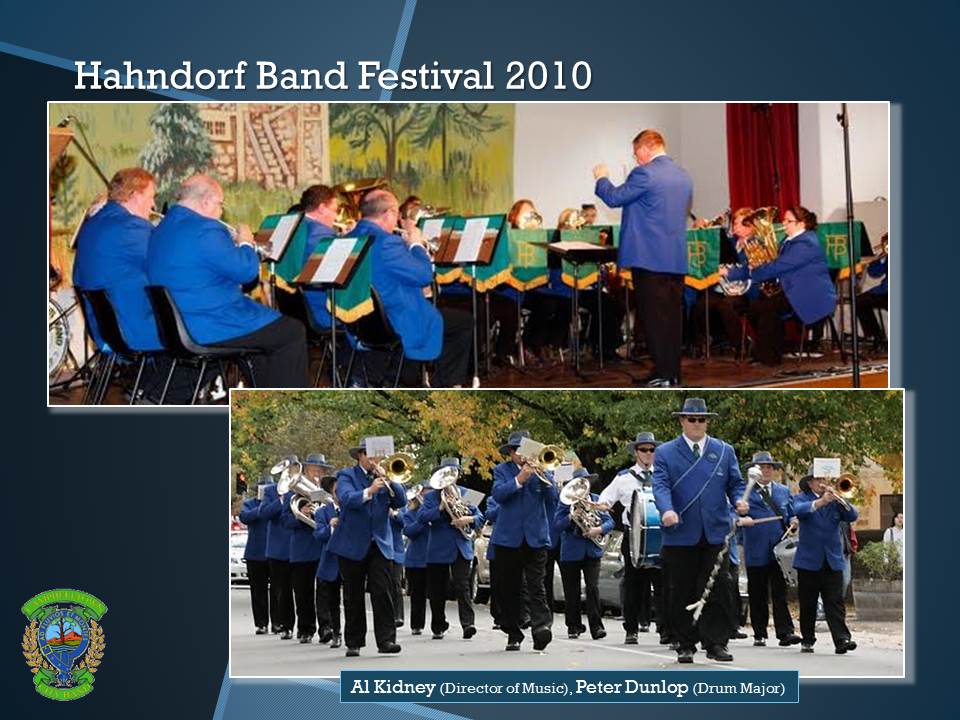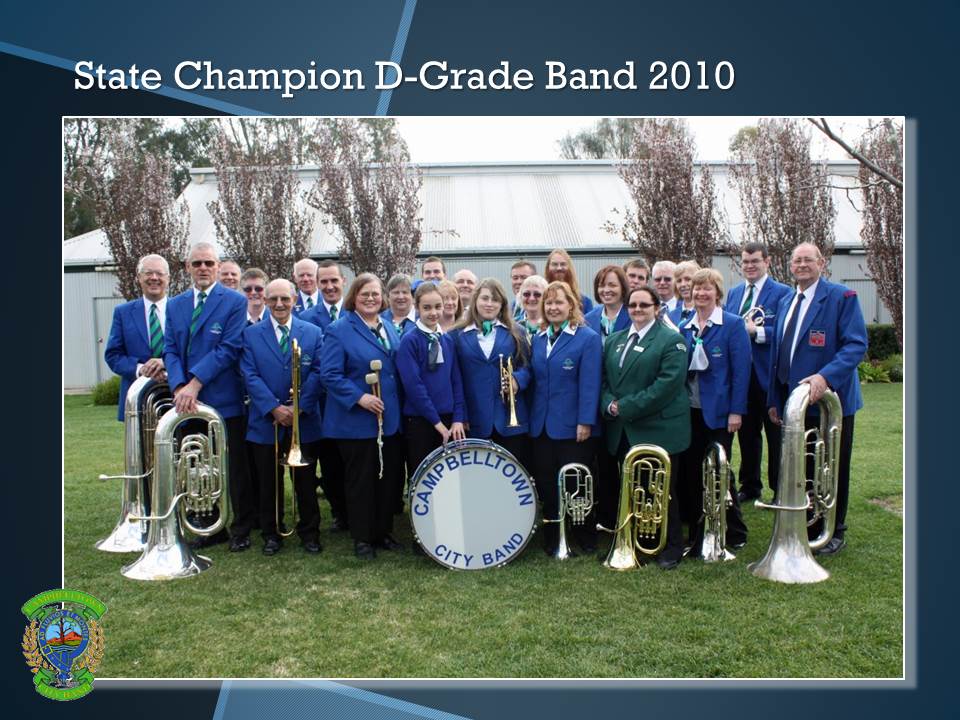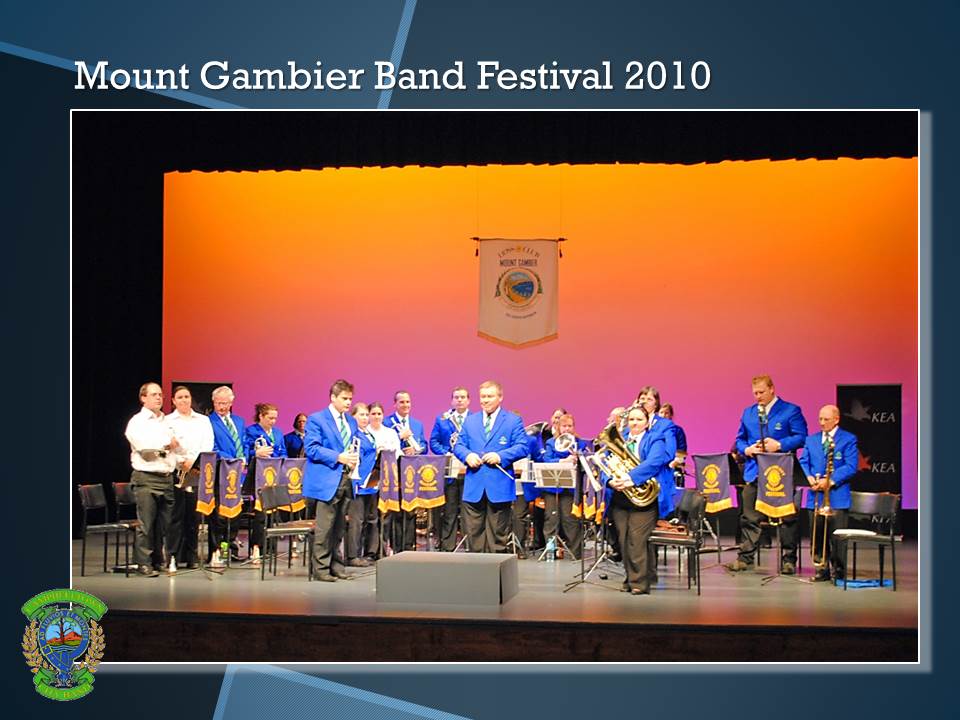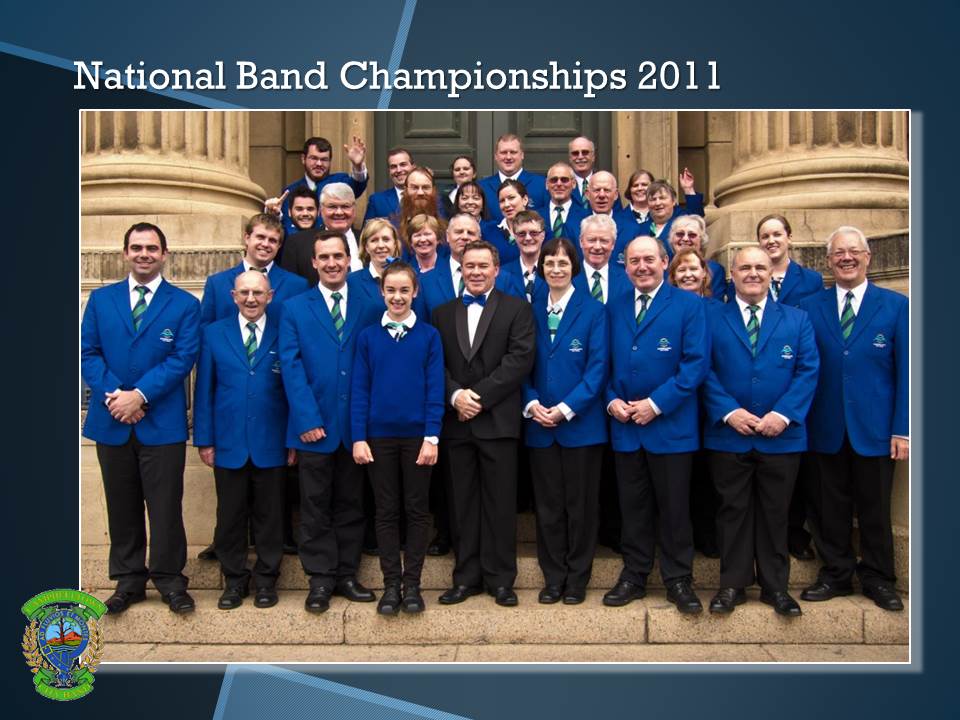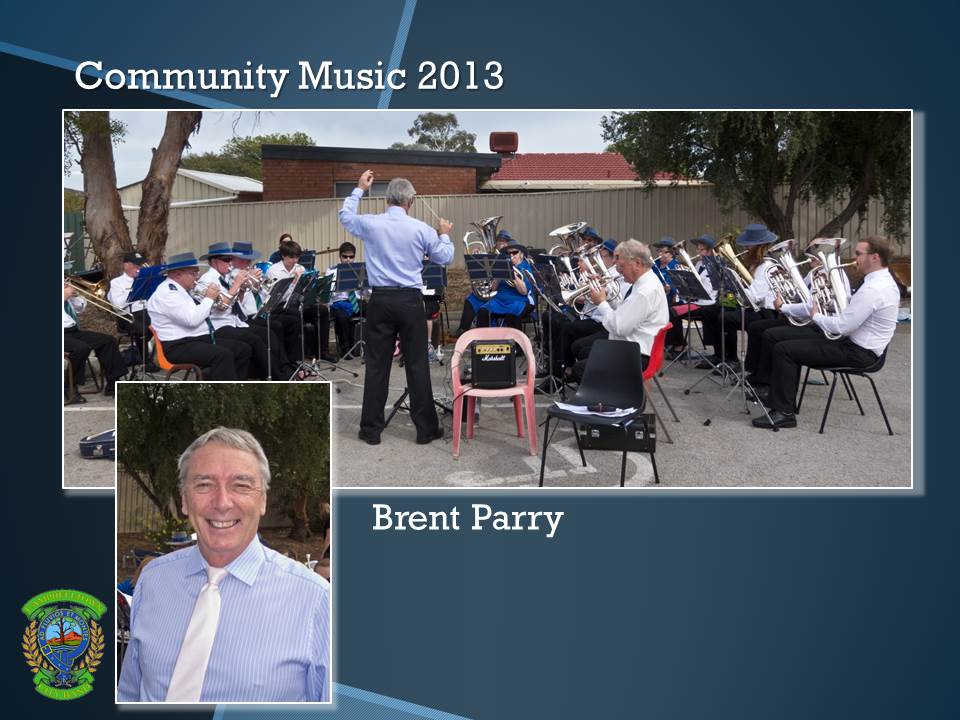History of the Campbelltown City Band
(Text taken from a talk presented by Brenton Brockhouse to the Campbelltown Historical Society April 2013)
In the late 19th century the predominantly farming communities in the Eastern suburbs of Adelaide had many small groups of men who came together to play brass band music for their own enjoyment and for that of their communities. Magill Silver Band, Magill Model Brass Band, Magill Vice-Regal Band, Athelstone Brass Band, Eastern Suburban Juvenile’s Band, East Adelaide Brass Band, and Eastern Star were just some of the small bands in local communities.
The earliest reference I can find to Athelstone Brass Band is in the SA Register of 30th November 1896 and then in The Advertiser in 1897.
Magill and Athelstone and Payneham Bands were mentioned in The Advertiser of 1902 as amongst the 100 South Australian bands expected to play the Coronation Prize March at half-past 9 on Saturday evening, 9th August 1902 on which day his Majesty the King will be crowned.
Apparently not all was smooth sailing for Athelstone as a newspaper report of 1907 refers to a concert in aid of the local brass band. (Certainly not Campbelltown Band) and by 1908 the Athelstone band is reported to be in difficulties and unable to pay their instructor. Also in 1908 a move was made to establish a brass band in Campbelltown. Was this to save Athelstone or start Campbelltown?
In 1911 it was reported in the SA Register that the Athelstone and Campbelltown Brass Band performed. A single combined band by the sounds of it rather than separate bands.
Now the earliest photo in our band archives is labelled Murray Park Band, pictured around 1914. I believe this eventually became the St Peter’s Brass Band and eventually the Payneham Concert Band. But surprisingly there are Campbelltown identities in this band. Chummy Austin, Don Robinson, Harry Markwick, Fred Farnham, Charlie Arnold. So I’m a little confused: Is this a forerunner of the Campbelltown Band? Note the “ring-in” in the back row with different uniform and a clarinet!
I have read that it was in 1919 that the Campbelltown Brass Band was officially formed by Mr Arthur Hazelwood. It consisted of young learners and market gardeners, all male of course. But just because it is written down doesn’t mean it is correct. I have tried very hard to obtain original primary source documents but have drawn a blank. I do know that Arthur Hazelwood died in 1948 and is buried at St Martin’s.
This undated photo must be prior to 1930 when uniforms were first provided. The note on the back reads “One of the Farnham boys 2nd from right”. The bandmaster is neither Jack Homewood not Wally Cox so could it be Arthur Hazelwood and could it be around 1920? Do the clothes give any clues?
This is another unlabeled photo of the band. No uniform. Does the car in the background give a clue to the date?
Compared with dated photos of other bands I’ve seen it would seem this is taken after WWI when military uniforms were out and civilian dress was in.
The annotation on the back of this photo indicates it is of Mr Jack Homeward and that he was Musical Director from around 1920 to 1933.
But research shows it was actually Jack Homewood. Did Arthur Hazelwood not continue for long or is the information, only recently recalled, not correct? (No records of John Homeward – but John Homewood died in 1933 and is buried at St Martins.)
Jack is shown in the uniform of the Campbelltown Silver Band so the photo is likely to have been taken after 1926.
The SA Register of November 1920 reports that Campbelltown Brass Band played at a Church Parade for various Friendly Societies. An unequivocal report but they get the Musical Director’s name as Jack Homeward instead of Homewood. Confusing.
From this time on there is no reference to Athelstone Brass Band in the Newspapers but only Campbelltown.
The Advertiser reports of a function held on Saturday 24th November (supposedly in 1917) in aid of the Campbelltown Brass Band. So was the band in existence prior to 1919? Let’s dig a bit deeper. The 24th November occurred on a Saturday in 1917, 1923, 1928 and 1934. In the absence of other supporting evidence it was unlikely to be 1917. There is a newspaper report of an almost identical function held in November 1924 and again in 1928. When on a good thing etc. But by 1928 the name had changed. So 1923 seems likely.
In 1926 the band went up-market and changed its name to the Campbelltown Silver Band. In fact in July 1926 it was Campbelltown Brass Band but by November of the same year it was the Silver Band. And another Continental and another Ugly Man competition!
The term ‘silver band’ is the same as ‘brass band’ but in those days ‘brass’ instruments were not as costly as silver plated ones, and the term ‘silver band’ implied a band that could afford high grade instruments and thus were a more successful band.
At the same time the band was fitted out with their first uniforms; blue navy style jacket, white trousers and caps.
Alwyn Munchenberg, who died in 2008 aged 104 was a member of the Campbelltown Silver Band in the 1920s to 1930s. Pity he was blind and could not recall those early days but we did obtain several photos from his archives: in fact the ONLY photos of the white trousered uniform. The Munchenberg property was on the site that is now the Campbelltown Shopping Centre. It was a popular tourist destination in the 1930s.
The band must have been quite good at this time as it played at the Elder Park Rotunda in December 1931.
Just contemplate white trousers in the Campbelltown market garden environment! Not such a good idea. They probably didn’t last long as this next photo shows the players with more conventional black trousers.
Jack Homewood died in 1933 and the band was taken over by Mr William Cox who transferred from Payneham Brass band.
This photo is undated but would appear to be in the mid-1930s. Perhaps it is in 1936 for the South Australian Centenary celebrations. It is likely this photo was taken near the old St Martin’s Anglican Church where the band rehearsed.
Every player is named on this photo too so we have the Farnham brothers, the Markwick brothers, the Parson brothers, Moyle, Wilkey, Lucas and the young boy, Ron Gambling on the right.
During 1936, South Australia’s centenary year, the band was very active performing and marching on a great number of occasions. As is the case nowadays the band was active in helping raise money for worthy causes. It appears from the Advertiser reports in 1939 and again in 1940 that the Munchenberg property was opened for visitors once a year to raise funds for the Children’s Hospital: and of course the Campbelltown Brass Band provided the musical entertainment. Looks like the band’s name had changed back again.
In this era Brass Bands were the poor man’s orchestra. Few people had access to records and those that did had to contend with 3 minutes a side for fragile 78rpm records. Live music ruled. For many, the community brass band provided the only music they could listen to apart from that on crackly radio. Inevitably there was a large following for each band and competitions became significant times in the community calendar. Huge numbers of people followed their local band even in Campbelltown.
During the Second World War the band went into recess, reforming in 1947 with Mr H Lukas as Bandmaster. A Boys Junior Band was started in 1950 with Mr Jack Zidlieke as Bandmaster and this revived community interest. The name was changed to the Campbelltown Municipal Junior Band to reflect the new direction.
Here is the junior band on a picnic to The Gorge on December 30th 1950. A picnic but with their instruments!
Rehearsals were held twice a week in the St Martin’s Church Hall.
Now this is a period that we could say is not ancient history as many of these boys would still be alive today.
By the late 1950s the band was in the doldrums again with worn out instruments, worn out uniforms and with no place to rehearse or store equipment contributing to low morale.
But in 1957 Mr Eddie Collins, a music teacher, was appointed Bandmaster and the band began to grow rapidly into a significant musical force.
In April 1959 Irvine Nicholson negotiated with the Army for the Campbelltown Band to be signed on as a unit of the Citizens Military Force 43/48 Btn. based at the Torrens Parade Ground in a ceremony at the Kensington Drill Hall. In return for providing all the military ceremonial music for the Army the band was provided with a uniform, two in fact (khaki and navy blue ceremonial dress), a place to rehearse, a full set of good instruments and the motivational challenge. Nothing succeeds like success and this was just the impetus that was needed.
The band provided ceremonial music for a period in excess of 5 years. We still have music in out library bearing the 43/48 Btn. name.

The band’s civilian name changed to the Campbelltown Municipal Band to reflect the number of adults rather than youngsters in the band. This was a serious time for the band with serious military practice for both music and for the drill required for Army displays. The Army permitted Campbelltown to compete and to take engagements in the dress uniform and to retain any income.
Look at this fine bunch of men posing at the Tanunda State Competitions in 1960. No-one looks a day over 40. Youngsters in the prime of their life. No wonder they were good at marching.
The band did need to raise funds so in 1960 the band put on a Mock Wedding. There were no women players in the band so they had to improvise. Not sure what we would think of this today but it is a good way to embarrass people.

In 1961 Campbelltown became a City and so the band name changed to the Campbelltown City Band, a name that has stayed unchanged now for almost 50 years.
A story was told that in those days of restricted pub hours, the band club was very popular with the men on Sundays when wives and families wondered about the long hours of “practice” the men put into at the band room! A fire in the refrigerator soon dampened enthusiasm.
Along with the benefits of joining the military came the costs. Frequent training camps at El-Alamein near Port Augusta, fire arms training and eventually First-Aid training and long hours away from family. Over half the weekly rehearsal time was spent on drill and other non-musical training. This eventually became too much and the band severed the relationship with the Army amicably and looked for a new direction.
In 1962, with the help of the Council, the revitalised band purchased new red military style uniforms with peaked caps for concerts and white pith helmets and brass accessories for marching. Not only did they look spectacular but apparently they sounded good too.
Then in 1963 the band purchased new instruments too and the band entered, and was successful in winning, many State competitions at Tanunda, Renmark, Port Augusta, and Norwood. Most of the trophies in our band room come from this period. Certainly the large trophies that need polishing seemed the thing. These days the trophies are smaller but we still have a lot of those old instruments.
The band consistently won the Tanunda Street March competitions as our room of trophies proves. In this photo their Drum Major, John Wilson is accepting a cup trophy for the street march in 1965. Look at the number of people.
The band marched in the Kimba and Whyalla Christmas Pageants for over 15 years and provided musical entertainment for the district. On these occasions, as well as marching in the parades, the band usually played a concert somewhere for a hospital or in the town square, occasionally forming two smaller groups to be in two places at the same time, as well as a cabaret on the Saturday night with jazz and/or swing bands. Sometimes the jazz players were so fired up they carried on most of the way home on the bus trip home from Whyalla on the Sunday. (Obviously in the days before seatbelts!)
The dance band played regularly in the 60s and 70s at Whyalla and the whole band played at events to raise money for the Kimba-to-Whyalla pipeline. Surprisingly this project only started in 2006 and was only completed in 2007. (With woodwind friends the band turned out both Dixieland and 16 piece “big swing bands” for such occasions. For several years, with some German music from the German Consul, the band played for Schutzenfest at Hahndorf from 10am to midnight non-stop, featuring a big German concert band; “Schnickelfritz Oompah Quintet” [two Clarinets, Trumpet, Trombone, Tuba]; Dixieland band and the Big Swing band…all from the members of the Campbelltown City Band plus a few non brass friends. A tough gig. )
In the decades before the American Marching Band spectaculars at their football matches, the Campbelltown City Band entertained crowds with their musical prowess as well as their intricate marching manoeuvres.
In those days Marching Girls had to be registered with a brass band and Campbelltown City Band supported three teams of girls competing as “The Cambelles” marching along with the band in Christmas pageants and other events.
The decade of the 1960s was indeed the heyday of the band, rising from a good D-grade band to B-Grade level in State competitions. But it was certainly their marching skills which attracted most attention and prizes.
In 1965 there was talk about the band building its own band hall complete with stage, practice rooms and concert facilities and a building fund was started. However they had to make do with “Packer’s Hut”, a corrugated iron and timber remnant from WWII.
Not only was the band invited many times to march in the prestigious annual John Martin’s Christmas Pageant, but in 1970 it became the first community band to lead the Adelaide Festival of Arts opening procession.
For one John Martin’s Pageant, Campbelltown joined with the local pipe band, using music from Major Jock Howie, Musical Director of the Scots Guard, with the band marking time for a few paces while the pipers and their drummers marched to the front for their ‘solo chorus’ before returning to the mass ranks as the total ensemble of band and pipes resumed. Shades of the Edinburgh Tattoo.
George Charlton told me the story of the band club rooms being raided by the police one Sunday at 4:05pm – 5 minutes after the supposed closing time. Someone had sold a beer to a young lad. The judge set the fine at exactly the amount the band had collected in beer sales that day. Whew! That band club is no longer in existence.
Naturally this upset the band members a little and morale dropped. Their only euphonium player left so Eddie Collins took that on while Irvine Nicholson took over the conducting. This kept the band together for the early years of the 70s still competing and winning awards.
This is a programme of a concert in the 1970s when Irvine was conductor. Notice the orchestral music by Beethoven, Wagner, Gabrielli, Tchaikowsky, Schubert, Bantock, Rossini, but then there are specific brass band items as well. The Arnold piece “Little Suite for Brass” is still played today as is the opening march.
However players drifted away and extra help was often required for engagements. Not only brass instrumentation but clarinets and saxophones were helping out at engagements. Shock, horror!
When Eddie Collins left in the early 1970’s the band fell on hard times and nearly went out of existence. The closely fought election of Mr Hal Hall as Musical Director in mid 1970s sharply divided the band. Clarinets, saxophones and other concert band instrumentation were introduced on a regular basis but many brass players left for other pure brass bands. Eventually the concert band could not continue either and it folded. In fact the band club folded and dividends were paid out to all members.
Hal Hall was head of Jazz Studies at the Elder Conservatorium and is still around in the district and was conductor of Hahndorf Town Band for a short time a few years ago.
The remaining brass band stalwarts, about 5 or 6 of them, struggled to keep Campbelltown City Band alive even though divisions and differences of opinion as to the brass band style and repertoire still existed. A number of interim Musical Directors struggled to retain enthusiasm, increase competencies, and train the younger learners. Amongst those were Ron Partridge, and Jamie Wyness.
With the return of Mr Eddie Collins in 1981 things started to look better again. Also the combined efforts of the Band, Campbelltown Football Club, East Torrens Cricket Club and the then Progress Association led to a new liquor licence. Apparently that encouraged new players!
The first AGM for many years was held in 1981 and Herb Reid was elected Chairman. Unfortunately Eddie Collins did not stay and Miss Shelley Spencer was appointed in June 1982. Shelley built the band back up to 25 members, mainly juniors, but she had to move interstate for work in 1984.
Interesting comment in the band committee meeting minutes of the time. “Shelley expressed the wish of female members of our Band for skirts to be permissible when appearing in concerts. The Committee did not wish to give approval at this stage…”
Funny how traditional band uniforms based on military appearance favour the men’s build. We had a similar problem in the 1990s.
In November 1984 Des O’Neill was appointed as the Musical Director. He started working with younger people, including his own son, Ricky and young Andrew Barnett.
The band at the 1989 Tanunda Championships with Des O’Neil. Now we start to see names of people who are still in the band. Wendy Merifield, John and Mary Rhodes, Tracy Cook.
It was in the mid 1980s that the old army surplus Nissan hut that had been the band’s store and practice room (and club) disintegrated to an unsafe condition. Campbelltown City Council eventually demolished it after the band moved out – thankfully not before.
After much discussion the band contributed funds to the Campbelltown City Council to enable the building of the current Senior Citizen’s Club so that the band could use their old room as the current store. Rehearsals were then held in the Memorial Oval Hall – and have been ever since. Eventually this turned out to be a happy arrangement all round but it broke the band.
This era from 1990 coincides with my involvement in the band as my eldest son started playing trombone for the band and as a good and faithful father I followed suit. Now my youngest son Chris plays Tenor Horn in the band and is Deputy Musical Director. I was President for a number of three year terms.
This too was the time when the annual Bandstand Brass concerts were held in the Campbelltown Function Centre. They are still going strong and an annual concert is held usually in June.
Under Des’s patient guidance the band won the ‘D grade’ Championships at the S A Competitions at Tanunda in 1993, and were allowed to move up to the next level, ‘C grade’.
The Campbelltown City Band has been actively involved in Anzac Day celebrations for many years, and, as can be seen in this 1995 photo, we had a big marching band.
Lest you think marching comes naturally, let me assure you it does not and many hours have been spent rehearsing this most unnatural activity on the Memorial Oval – often to the amusement of other oval users.
Unfortunately Des O’Neill became ill with emphysema and passed away in March 1996 aged only 46.
David Barker was appointed Musical Director in 1996. During David’s time as Musical Director, the band enjoyed many successful competitions in ‘C grade’ reaching a creditable second place in the State competitions.
It is also the time of the Athelstone Lion’s Club “Carols in the Park” and the Rotary Rotunda at Thorndon Park.
In March 1996 the Council assisted the band purchase some new instruments. Remember that most of our instruments came from the 1960s with only a few of the less expensive being replaced by the band so the help from Council and Service Clubs like the Athelstone Lions Club enabled the tuba, baritone and tenor horn to be purchased.
However in July 1997 David left the band to further his career in the Hunter Valley vineyards.
Stuart Jones took over when David left. Stuart concentrated on encouraging young people from local schools to be involved in brass bands. His career as a professional music teacher enabled him to develop a good rapport with younger people. Stuart will be best remembered for two memorable concerts, one with tunes from the opera as the theme and players dressed in tuxedos and bow ties, and the other as Christmas in July with a full Christmas dinner included in the concert.
He also took the band to the Broken Hill Bands Festival in 1998 where they came second amongst some big boys.
In 1999 Campbelltown competed in C Grade in the National Brass Band Competitions held in Adelaide. No prizes were won but we did come third in the Hymn Section, but it was possibly the first time the band had ever competed in a Nationals Championships.
Unfortunately Stuart left the band in October 2000.
Just as aside: When doing research and using Newspapers as references you do need to be a little careful. Not is all as it seems. This report would imply Campbelltown won everything at the 1999 Tanunda Championships. We won the entertainment music section in a Tanunda Entertainment Festival – not the State Championships. But a win is a win.
Peter Monk, the band’s leading euphonium player was then appointed Musical Director in November 2000 and continued till 2005. While the band did not compete in any more competitions it was still actively involved in several Band Festival where fun and entertainment were more significant.
Campbelltown City Band was always highly visible on a march with its red jackets and white pith helmets and remained one of the few civilian bands to retain a military appearance. I might add that although those helmets looked good they were not at all comfortable to wear. (That’s why we were able to buy some from the Police Band when they upgraded)
But sometimes we let our hair down and look far from military. This is the band ready for the Mt Barker Christmas Pageant in 2005. The band was a big hit with the community.
Chris Bowman was appointed Musical Director in June 2005. Upon his commencement, Chris immediately went about addressing the future of the band. The mission and purpose of the band was readdressed as too was the appearance. Anyone who looked like this while playing was obviously not a good advertisement for the band!
We had a proud tradition of red military style jackets and white pith helmets but Chris could see this was not attractive to prospective new members and certainly not to the younger ones.
With the assistance of the Campbelltown City Council a new modern uniform was purchased. The blue jackets also better reflected the Council colours. (As an aside the jackets are made in Adelaide and support a SA business – but at great cost)
Chris brought a new enthusiasm to the band and the members responded brilliantly. A few successful community engagements also lifted morale and skills and new players started to come through the doors. In just twelve months, the Campbelltown City Band had reinvented itself, appraised what a brass band could mean to the 21st century community, and adapted accordingly.
In 2006 a learners group was formed and the Torrens Brass Learners’ Band inaugurated. This was so successful in engaging the youngsters that many persuaded their parents to join and learn too. Unfortunately Chris moved interstate.
Danny Dielkens was then appointed Musical Director in late 2006 and continued this great work with his infectious enthusiasm.
Danny was yet another Adelaidean immersed in the music world and Campbelltown benefitted immensely from his knowledge
But in early 2007 Danny moved to a permanent musical position in Melbourne meaning the band once again was looking for a new Musical Director.
Another newspaper article but this one is quite correct. With fewer and fewer band members able, or willing, to march it was opportune to combine with other bands in the same boat to provide a good band for street marches, particularly the Anzac one.
We have combined with Mitcham, Hahndorf, Para Hills and Payneham players over the time. This continues to this day.
Campbelltown City Band then appointed Al Kidney as Musical Director from mid-2007. Al had a serious banding background and is currently Bandmaster with the SA Police Band and is involved with three or four other bands in Adelaide. He generated much excitement amongst the members with many new players attending.
Sarah Butler was appointed Musical Director of Torrens Brass in 2007. She had previously had great success with the learners group from Hahndorf Town Band and Campbelltown were pleased to gain her services.
With the influx of new players and with new learners, the band competed in the D grade section at the State Band Championships held at Tanunda in October 2007, winning that section street march.
Under Al’s direction the band stepped out of its comfort zone and attempted new ventures and new concerts. We still put on our annual concert and participated in the usual Christmas pageants but we tried new ideas. We played a concert at Willunga Uniting Church and also for their Carols in the Paddock.
I mentioned “comfort zone”, well it gets very cold at night at Willunga but the lovely people there fed us with nice hot food.
We took part in the Strathalbyn Bands Festival for the first time. This is a great contest in that there are few rules. It is about playing music to entertain the crowd rather that appease an adjudicator. We all enjoyed it immensely. It was also a ‘baptism of fire’ for our newly appointed Deputy Musical Director, Chris Brockhouse.
In 2009 we put on a community concert in conjunction with the Payneham Concert Band. Many of our players play in both bands so it was appropriate to combine with our friendly neighbours. Each band played a selection of music then we all combined as one large band. We still do this each year and it is great fun.
I find it amusing that in 1933 the conductor of Payneham transferred to Campbelltown and now 80 years later we have joint concerts and a high level of cooperation between both bands. Music is such fun!
The band provided music for the official opening of the Magill RSL War Memorial by His Excellency, Rear Admiral Kevin Scarce AC CSC RANR, Governor of SA in November 2009.
In 2010 the band also took part in the Hahndorf Band Festival for the first time ever, coming third in the street march.
In September 2010 the band competed in the State Band Championships at Tanunda and came first in all D-Grade sections. Very exciting but there wasn’t a lot of competition in this grade. But a win is a win.
In November 2010 Campbelltown ventured to Mount Gambier for the Blue Lake Bands Festival. Another first for this band for many years. And we came first in the D‑Grade section of both the Street March and also the Music section. Most rewarding both socially and musically.
Our next jump from the comfort zone was competing in the National Band Championships held in Adelaide in April 2011. This was big time. Although still at D‑Grade we were thrilled to gain two 1sts, one 2nd, and two 3rds to come in overall 3rd in Australia. The four trophies take pride of place in our display.
Al Kidney resigned in early 2013 after 5 years with us.
In February 2013 the band appointed Brent Parry (who also conducts Payneham Concert Band) so this heralds a period of even greater cooperation between these two music making groups in the community – and history repeats itself somewhat.
This concludes our history up to now but I would like to point out that while we have of necessity been looking backwards, we are not a backward looking band. We don’t pine for the days gone by but strive for the days that are now and are yet to come. We understand our history in order to build for the future.
Campbelltown City Band does have a bright future as a community band.























